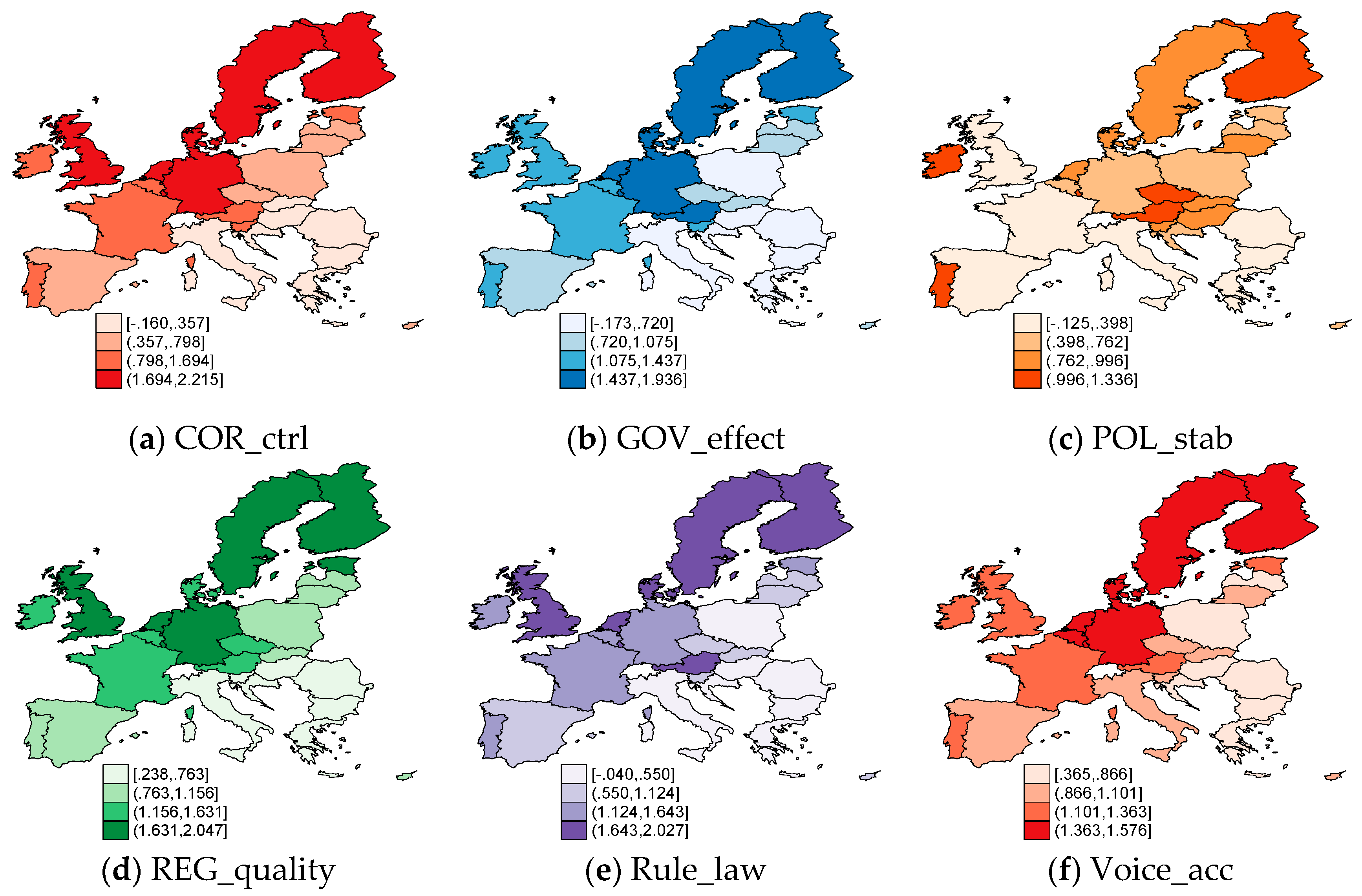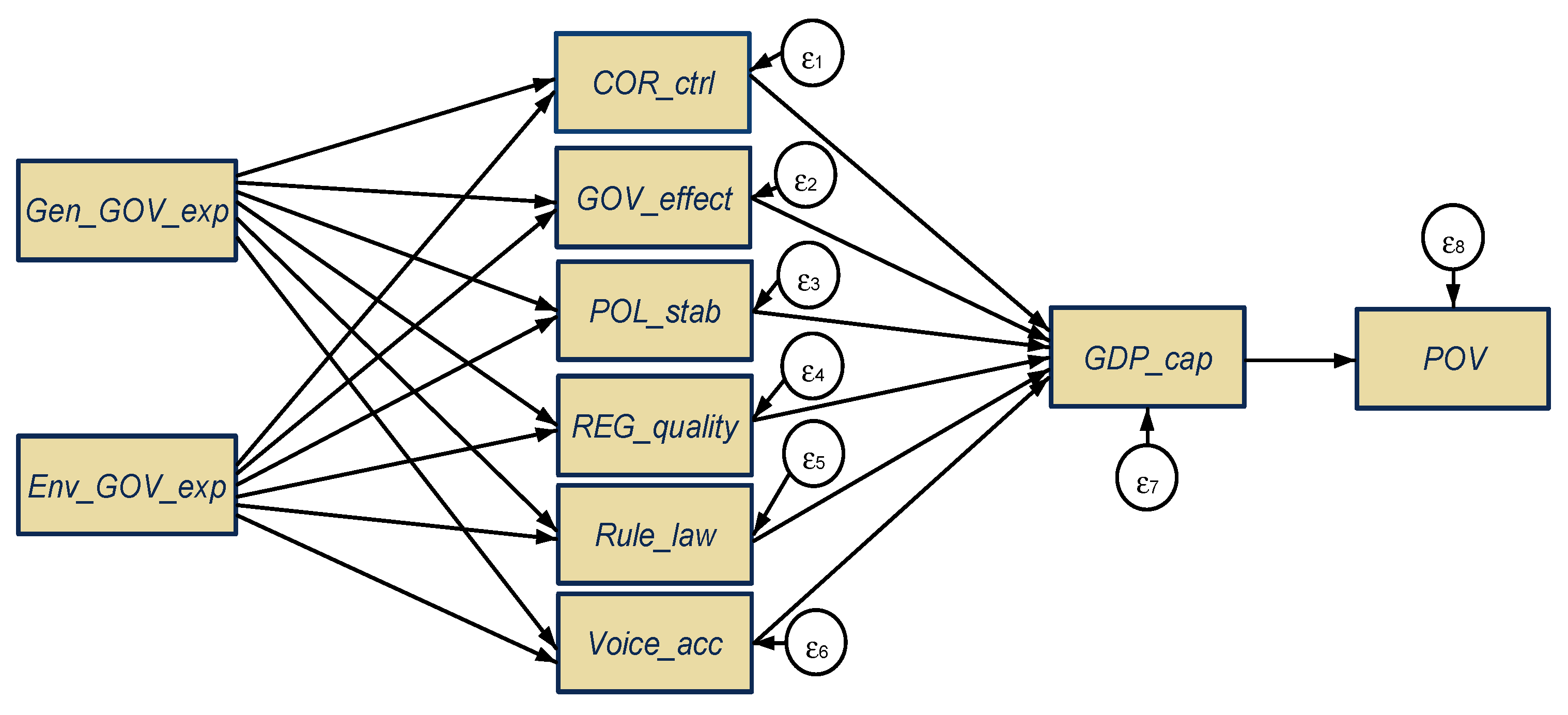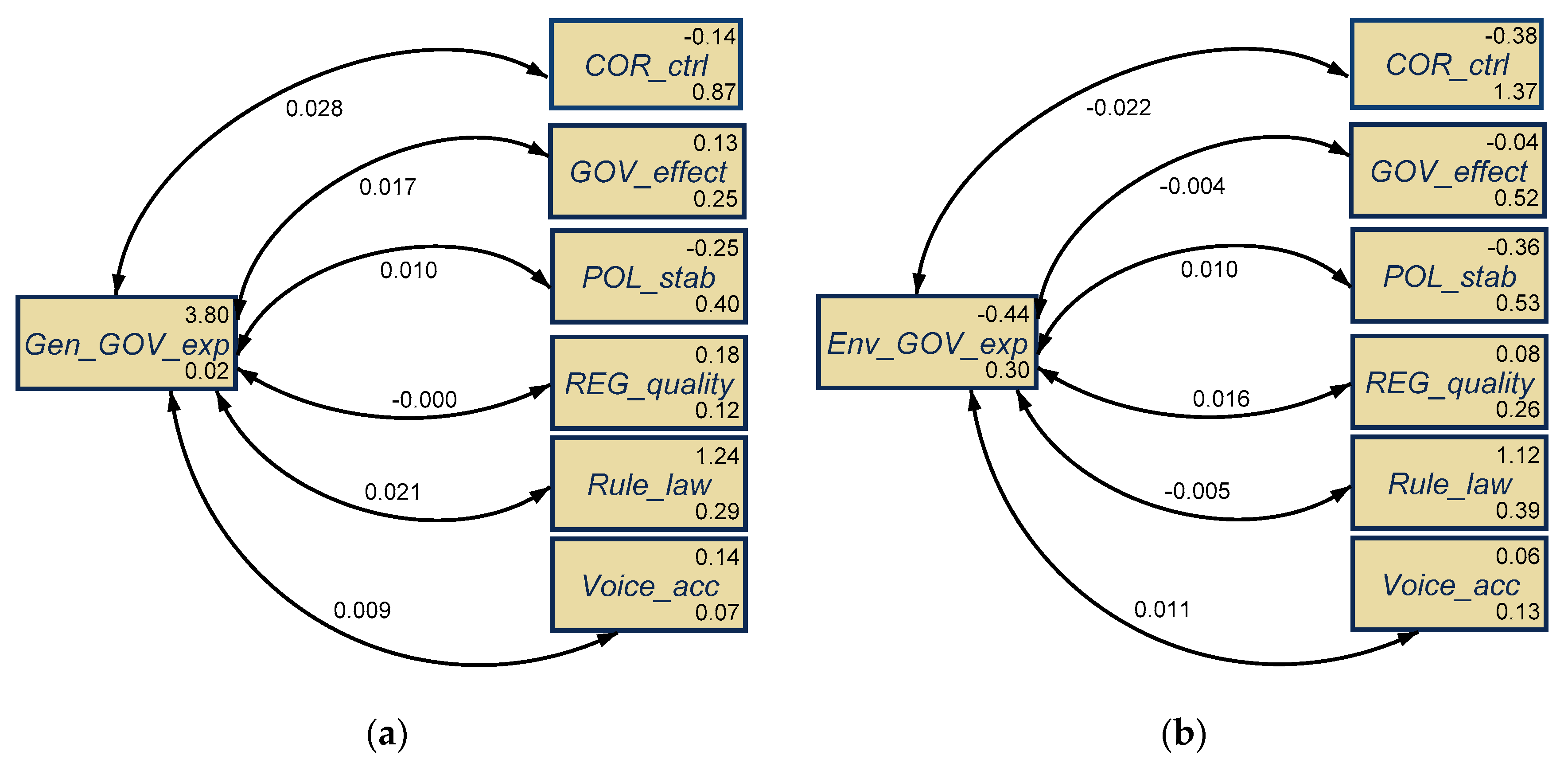Interlinkages between Government Resources Management, Environmental Support, and Good Public Governance. Advanced Insights from the European Union
Abstract
1. Introduction
2. Brief Literature Review
2.1. Public Government Spending Management and Good Governance: Interplay, Measurement
2.2. Public Governance Management and Sustainable Socio-Economic Development
3. Data and Methodology
3.1. Data
- governance indicators: “Total general government expenditure (% of GDP) (Gen_GOV_exp)”; “Expenditure of general government on environmental protection (% of GDP) (Env_GOV_exp)”; “Control of corruption (rank between −2.5 and 2.5) (COR_ctrl)”; “Government effectiveness (rank between −2.5 and 2.5) (GOV_effect)”; “Political stability and absence of violence/terrorism (rank between −2.5 and 2.5) (POL_stab)”; “Regulatory quality (rank between −2.5 and 2.5) (REG_quality)”; “Rule of law (rank between −2.5 and 2.5) (Rule_law)”; “Voice and accountability (rank between −2.5 and 2.5) (Voice_acc)”;
- economic and social indicators: “GDP per capita (constant 2010 USD) (GDP_cap)”; “People at risk of poverty or social exclusion (% of population) (POV)”.
3.2. Methodology
4. Results and Discussions
5. Concluding Remarks
Author Contributions
Funding
Institutional Review Board Statement
Informed Consent Statement
Data Availability Statement
Conflicts of Interest
Appendix A
| Variables | (1) | (2) |
|---|---|---|
| Gen_GOV_exp → GPG | Env_GOV_exp → GPG | |
| log_COR_ctrl | ||
| log_Env_GOV_exp | −0.0560 (0.101) | |
| log_Gen_GOV_exp | 1.383 *** (0.294) | |
| GPG | 1 (.) | 1 (.) |
| _cons | −5.403 *** (1.121) | −0.411 *** (0.0667) |
| log_GOV_effec | ||
| log_Env_GOV_exp | −0.0160 (0.0624) | |
| log_Gen_GOV_exp | 0.820 *** (0.156) | |
| GPG | 0.537 *** (0.0162) | 0.594 *** (0.0174) |
| _cons | −2.992 *** (0.594) | −0.0442 (0.0408) |
| log_POL_stab | ||
| log_Env_GOV_exp | 0.0278 (0.0627) | |
| log_Gen_GOV_exp | 0.467 * (0.202) | |
| GPG | 0.288 *** (0.0335) | 0.359 *** (0.0260) |
| _cons | −2.027 ** (0.768) | −0.348 *** (0.0420) |
| log_REG_quality_est | ||
| log_Env_GOV_exp | 0.0511 (0.0434) | |
| log_Gen_GOV_exp | −0.0185 (0.113) | |
| GPG | 0.382 *** (0.0120) | 0.389 *** (0.0136) |
| _cons | 0.255 (0.428) | 0.100 *** (0.0286) |
| Log_Rule_law | ||
| log_Env_GOV_exp | −0.0163 (0.0526) | |
| log_Gen_GOV_exp | 1.034 *** (0.166) | |
| GPG | 0.611 *** (0.0150) | 0.532 *** (0.0145) |
| _cons | −2.690 *** (0.631) | 1.111 *** (0.0349) |
| log_Voice_acc | ||
| log_Env_GOV_exp | 0.0355 (0.0311) | |
| log_Gen_GOV_exp | 0.459 *** (0.0833) | |
| GPG | 0.281 *** (0.00894) | 0.308 *** (0.00824) |
| _cons | −1.602 *** (0.317) | 0.0748 *** (0.0206) |
| var(e.log_COR_ctrl) | ||
| _cons | 0.151 *** (0.0113) | 0.123 *** (0.0111) |
| var(e.log_GOV_effec) | ||
| _cons | 0.0378 *** (0.00282) | 0.0772 *** (0.00599) |
| var(e.log_POL_stab) | ||
| _cons | 0.335 *** (0.0220) | 0.374 *** (0.0237) |
| var(e.log_REG_quality) | ||
| _cons | 0.0222 *** (0.00163) | 0.0687 *** (0.00473) |
| var(e.log_Rule_law) | ||
| _cons | 0.0100 *** (0.00167) | 0.0316 *** (0.00321) |
| var(e.log_Voice_acc) | ||
| _cons | 0.0129 *** (0.000971) | 0.0147 *** (0.00123) |
| var(GPG) | ||
| _cons | 0.681 *** (0.0538) | 1.262 *** (0.0959) |
| mean(log_Env_GOV_exp) | ||
| _cons | −0.445 *** (0.0218) | |
| var(log_Env_GOV_exp) | ||
| _cons | 0.300 *** (0.0169) | |
| N | 467 | 638 |
| Variables | (1) | (2) |
|---|---|---|
| Gen_GOV_exp | Env_GOV_exp | |
| mean(log_COR_ctrl) | ||
| _cons | −0.143 *** (0.0432) | −0.381 *** (0.0518) |
| mean(log_GOV_effect) | ||
| _cons | 0.128 *** (0.0230) | −0.0355 (0.0315) |
| mean(log_POL_stab) | ||
| _cons | −0.250 *** (0.0291) | −0.358 *** (0.0321) |
| mean(log_REG_quality) | ||
| _cons | 0.185 *** (0.0161) | 0.0771 *** (0.0222) |
| mean(log_Rule_law) | ||
| _cons | 1.240 *** (0.0247) | 1.118 *** (0.0271) |
| mean(log_Voice_acc) | ||
| _cons | 0.144 *** (0.0123) | 0.0591 *** (0.0159) |
| mean(log_Gen_GOV_exp) | ||
| _cons | 3.803 *** (0.00663) | |
| var(log_COR_ctrl) | ||
| _cons | 0.871 *** (0.0570) | 1.368 *** (0.0982) |
| var(log_GOV_effect) | ||
| _cons | 0.248 *** (0.0162) | 0.520 *** (0.0339) |
| var(log_POL_stab) | ||
| _cons | 0.396 *** (0.0259) | 0.533 *** (0.0334) |
| var(log_REG_quality) | ||
| _cons | 0.122 *** (0.00795) | 0.261 *** (0.0163) |
| var(log_Rule_law) | ||
| _cons | 0.286 *** (0.0187) | 0.389 *** (0.0238) |
| var(log_Voice_acc) | ||
| _cons | 0.0709 *** (0.00464) | 0.135 *** (0.00830) |
| var(log_Gen_GOV_exp) | ||
| _cons | 0.0205 *** (0.00134) | |
| cov(log_COR_ctrl,log_GOV_effect) | ||
| _cons | 0.395 *** (0.0282) | 0.747 *** (0.0537) |
| cov(log_COR_ctrl,log_POL_stab) | ||
| _cons | 0.185 *** (0.0285) | 0.415 *** (0.0438) |
| cov(log_COR_ctrl,log_REG_quality) | ||
| _cons | 0.252 *** (0.0191) | 0.471 *** (0.0360) |
| cov(log_COR_ctrl,log_Rule_law) | ||
| _cons | 0.444 *** (0.0309) | 0.668 *** (0.0445) |
| cov(log_COR_ctrl,log_Voice_account) | ||
| _cons | 0.211 *** (0.0151) | 0.385 *** (0.0266) |
| cov(log_COR_ctrl,log_Gen_GOV_exp) | ||
| _cons | 0.0284 *** (0.00633) | |
| cov(log_GOV_effect,log_POL_stab) | ||
| _cons | 0.123 *** (0.0156) | 0.277 *** (0.0268) |
| cov(log_GOV_effect,log_REG_quality) | ||
| _cons | 0.135 *** (0.0102) | 0.295 *** (0.0217) |
| cov(log_GOV_effect,log_Rule_law) | ||
| _cons | 0.242 *** (0.0167) | 0.399 *** (0.0264) |
| cov(log_GOV_effect,log_Voice_account) | ||
| _cons | 0.107 *** (0.00788) | 0.226 *** (0.0155) |
| cov(log_GOV_effect,log_Gen_GOV_exp) | ||
| _cons | 0.0169 *** (0.00339) | |
| cov(log_POL_stab,log_REG_quality) | ||
| _cons | 0.0668 *** (0.0106) | 0.153 *** (0.0182) |
| cov(log_POL_stab,log_Rule_law) | ||
| _cons | 0.131 *** (0.0167) | 0.238 *** (0.0227) |
| cov(log_POL_stab,log_Voice_account) | ||
| _cons | 0.0620 *** (0.00827) | 0.148 *** (0.0135) |
| cov(log_POL_stab,log_Gen_GOV_exp) | ||
| _cons | 0.00960 * (0.00420) | |
| cov(log_REG_quality,log_Rule_law) | ||
| _cons | 0.159 *** (0.0113) | 0.260 *** (0.0179) |
| cov(log_REG_quality,log_Voice_account) | ||
| _cons | 0.0765 *** (0.00557) | 0.155 *** (0.0106) |
| cov(log_REG_quality,log_Gen_GOV_exp) | ||
| _cons | −0.000380 (0.00231) | |
| cov(log_Rule_law,log_Voice_account) | ||
| _cons | 0.126 *** (0.00879) | 0.206 *** (0.0134) |
| cov(log_Rule_law,log_Gen_GOV_exp) | ||
| _cons | 0.0212 *** (0.00368) | |
| cov(log_Voice_acc,log_Gen_GOV_exp) | ||
| _cons | 0.00943 *** (0.00182) | |
| mean(log_Env_GOV_exp) | ||
| _cons | −0.445 *** (0.0218) | |
| var(log_Env_GOV_exp) | ||
| _cons | 0.300 *** (0.0169) | |
| cov(log_COR_ctrl,log_Env_GOV_exp) | ||
| _cons | −0.0218 (0.0301) | |
| cov(log_GOV_effect,log_Env_GOV_exp) | ||
| _cons | −0.00435 (0.0187) | |
| cov(log_POL_stab,log_Env_GOV_exp) | ||
| _cons | 0.0101 (0.0187) | |
| cov(log_REG_quality,log_Env_GOV_exp) | ||
| _cons | 0.0155 (0.0130) | |
| cov(log_Rule_law,log_Env_GOV_exp) | ||
| _cons | −0.00494 (0.0158) | |
| cov(log_Voice_acc,log_Env_GOV_exp) | ||
| _cons | 0.0106 (0.00935) | |
| N | 467 | 638 |
| Variables | (1) |
|---|---|
| Total (Effects on GDP_cap and POV) | |
| log_COR_ctrl | |
| log_Env_GOV_exp | −0.247 * (0.109) |
| log_Gen_GOV_exp | 1.336 *** (0.360) |
| _cons | −5.331 *** (1.366) |
| log_GDP_cap | |
| log_COR_ctrl | −0.158 *** (0.0442) |
| log_GOV_effec | 0.132 (0.0925) |
| log_POL_stab | −0.0629 * (0.0308) |
| log_REG_quality | −0.400 *** (0.107) |
| log_Rule_law | 0.698 *** (0.113) |
| log_Voice_account | 1.316 *** (0.148) |
| _cons | 9.251 *** (0.131) |
| log_GOV_effec | |
| log_Env_GOV_exp | −0.141 ** (0.0539) |
| log_Gen_GOV_exp | 0.770 *** (0.178) |
| _cons | −2.844 *** (0.676) |
| log_POL_stab | |
| log_Env_GOV_exp | −0.118 (0.0735) |
| log_Gen_GOV_exp | 0.150 (0.243) |
| _cons | −0.901 (0.922) |
| log_REG_quality | |
| log_Env_GOV_exp | −0.0702 (0.0398) |
| log_Gen_GOV_exp | 0.0457 (0.131) |
| _cons | 0.00142 (0.499) |
| Log_Rule_law | |
| log_Env_GOV_exp | −0.118 * (0.0594) |
| log_Gen_GOV_exp | 1.016 *** (0.196) |
| _cons | −2.645 *** (0.745) |
| log_Voice_account | |
| log_Env_GOV_exp | −0.00618 (0.0307) |
| log_Gen_GOV_exp | 0.503 *** (0.101) |
| _cons | −1.771 *** (0.385) |
| log_POV | |
| log_GDP_cap | −0.274 *** (0.0188) |
| _cons | 5.921 *** (0.194) |
| var(e.log_COR_ctrl) | |
| _cons | 0.848 *** (0.0656) |
| var(e.log_GDP_cap) | |
| _cons | 0.100 *** (0.00775) |
| var(e.log_GOV_effec) | |
| _cons | 0.208 *** (0.0161) |
| var(e.log_POL_stab) | |
| _cons | 0.386 *** (0.0299) |
| var(e.log_REG_quality) | |
| _cons | 0.113 *** (0.00874) |
| var(e.log_Rule_law) | |
| _cons | 0.252 *** (0.0195) |
| var(e.log_Voice_account) | |
| _cons | 0.0674 *** (0.00521) |
| var(e.log_POV) | |
| _cons | 0.0409 *** (0.00316) |
| N | 334 |
References
- The World Bank. Governance and Development; The World Bank: Washington, DC, USA, 1992. [Google Scholar]
- Houngbo, P.T.; Coleman, H.L.S.; Zweekhorst, M.; De Cock Buning, T.; Medenou, D.; Bunders, J.F.G. A model for good governance of healthcare technology management in the public sector: Learning from evidence-informed policy development and implementation in Benin. PLoS ONE 2017, 12, e0168842. [Google Scholar] [CrossRef]
- Lu, J.; Zhao, J. How does government funding affect nonprofits’ program spending? Evidence from international development organizations. Public Adm. Dev. 2019, 39, 69–77. [Google Scholar] [CrossRef]
- Noja, G.G.; Cristea, M.; Sirghi, N.; Hategan, C.-D.; D’Anselmi, P. Promoting good public governance and environmental support for sustainable economic development. Int. J. Environ. Res. 2019, 16, 4940. [Google Scholar] [CrossRef]
- The World Bank. Worldwide Governance Indicators (WGI) 2019. Available online: http://info.worldbank.org/governance/wgi/ (accessed on 22 November 2020).
- Kaufmann, D.; Kraay, A.; Mastruzzi, M. Governance Matters VIII: Aggregate and Individual Governance Indicators, 1996–2008 (29 June 2009). World Bank Policy Research Working Paper No. 4978. Available online: https://ssrn.com/abstract=1424591 (accessed on 22 January 2021).
- United Nations. What Is Good Governance? Economic and Social Commission for Asia and the Pacific 2009. Available online: https://www.unescap.org/sites/default/files/good-governance.pdf (accessed on 22 November 2020).
- Overseas Development Institute (ODI). Mapping Political Context: World Governance Assessment 2009. Available online: https://www.odi.org/publications/5531-mapping-political-context-world-governance-assessment (accessed on 24 November 2020).
- European Union. Manual on Sources and Methods for the Compilation of COFOG Statistics. Classification of the Functions of Government (COFOG); Publications Office of the European Union: Luxembourg, 2019. [Google Scholar] [CrossRef]
- United Nations. Transforming the World: The 2030 Agenda for Sustainable Development. 2015. Available online: https://sustainabledevelopment.un.org (accessed on 24 January 2021).
- Law, S.H.; Lim, T.C.; Ismail, N.W. Institutions and economic development: A Granger causality analysis of panel data evidence. Econ. Syst. 2013, 37, 610–624. [Google Scholar] [CrossRef]
- Bilan, Y.; Vasilyeva, T.; Lyeonov, S.; Bagmet, K. Institutional complementarity for social and economic development. Bus. Theory Pract. 2019, 20, 103–115. [Google Scholar] [CrossRef]
- Masca, S.-G.; Nistor, S.; Vaidean, V.L. Do government arrangements matter for CEE countries’ growth? A two-piece puzzle perspective. Appl. Econ. Lett. 2019, 26, 1612–1626. [Google Scholar] [CrossRef]
- Tarverdi, Y.; Saha, S.; Campbell, N. Governance, democracy and development. Econ. Anal. Policy 2019, 63, 220–233. [Google Scholar] [CrossRef]
- Bogere, G.; Mukaaru, J.A. Assessing Public Expenditure Governance: A Conceptual and Analytical Framework. ACODE Policy Research Paper 2016, 74. Available online: https://www.acode-u.org/uploadedFiles/PRS74.pdf (accessed on 22 January 2021).
- Fan, S.; Hazell, P.; Thorat, S. Government spending, growth and poverty in rural India. Am. J. Agric. Econ. 2000, 82, 1038–1051. [Google Scholar] [CrossRef]
- Kauffmann, D.; Recanatini, F.; Biletsky, S. Assessing Governance: Diagnostic Tools and Applied Methods for Capacity Building and Action Learning; The World Bank: Washington, DC, USA, 2002. [Google Scholar]
- Pere, E. Impact of good governance in the economic development of Western Balkan countries. Eur. J. Gov. Econ. 2015, 4, 25–45. [Google Scholar] [CrossRef]
- Bovaird, T.; Loeffler, E. Public Management and Governance; Routledge: London, UK, 2015. [Google Scholar]
- Turner, M.; Hulme, D.; McCourt, W. Governance, Management and Development. Making the State Work; Polgrave: London, UK, 2015. [Google Scholar]
- Tihanyi, L.; Graffin, S.; George, G. Rethinking governance in management research. Acad. Manag. J. 2014, 57, 1535–1543. [Google Scholar] [CrossRef]
- Srakar, A.; Vecco, M.; Tóth, Á. The tale of the cuts and raises: Public budgets for culture in the European countries during the financial crisis. Hacienda Pública Esp. 2017, 221, 83–109. [Google Scholar] [CrossRef]
- Stiglitz, J.E. Freefall: America, Free Markets, and the Sinking of the World Economy; WW Norton & Company: New York, NY, USA, 2010. [Google Scholar]
- Young, B. Economic Governance in the Eurozone: A New Dawn. Econ. Sociol. Eur. Electron. Newsl. 2011, 12, 11–16. Available online: http://hdl.handle.net/10419/155966 (accessed on 2 March 2021).
- Apaza, C.R. Measuring governance and corruption through the worldwide governance indicators: Critiques, responses, and ongoing scholarly discussion. PS Polit. Sci. Polit. 2009, 42, 139–143. [Google Scholar] [CrossRef]
- Kaufman, D.; Kraay, A.; Mastruzzi, M. The Worldwide Governance Indicators: Methodology and Analytical Issues. The World Bank Development Research Group Macroeconomics and Growth Team, World Bank Policy Research Working Paper 2010, No. 5430. Available online: https://ssrn.com/abstract=1682130 (accessed on 4 March 2021).
- Charron, N.; Lapuente, V.; Rothstein, B. Mapping the quality of government in Europe. In An Analysis at the National and Regional Level within the EU Member States; Swedish Institute for European Policy Studies (SIEPS): Stockholm, Sweden, 2018; Available online: http://www.sieps.se/globalassets/publikationer/2018/sieps-2018_2-web.pdf (accessed on 4 March 2021).
- Shonchoy, A. What is Happening with the Government Expenditure of Developing Countries–A Panel Data Study. In Proceedings of the German Development Economics Conference, Hannover, Germany, 18–19 June 2010. [Google Scholar]
- Welsch, H. Corruption, growth, and the environment: A cross-country analysis. Environ. Dev. Econ. 2004, 9, 663–693. [Google Scholar] [CrossRef]
- Law, S.H.; Azman-Saini, W.N.W. Institutional quality, governance, and financial development. Econ. Gov. 2012, 13, 217–236. [Google Scholar] [CrossRef]
- Huang, C.J. Governance and economic growth: Evidence of ten Asian countries. World Academy of Science, Engineering and Technology. Int. J. Soc. Behav. Educ. Econ. Bus. Ind. Eng. 2015, 9, 2071–2075. [Google Scholar] [CrossRef]
- Acemoglu, D.; Verdier, T. Property rights, corruption and the allocation of talent: A general equilibrium approach. Econ. J. 1998, 108, 1381–1403. [Google Scholar] [CrossRef]
- Vasileiou, E. Corruption, Political Stability and Public Finance: What the Data Say about the European Monetary Union’s Countries? A Note, 2015 (10 November 2015). Available online: https://ssrn.com/abstract=2688822 (accessed on 22 February 2021). [CrossRef]
- Park, J. Corruption, soundness of the banking sector, and economic growth: A cross-country study. J. Int. Money Financ. 2012, 31, 907–929. [Google Scholar] [CrossRef]
- Gil, A.R.; Vishwanathan, K.K.; Hassan, S. Effects of Governance on the Environmental Kuznets Curve (EKC) in South and South East Asian Countries. Pak. J. Soc. Sci. 2019, 39, 1101–1114. [Google Scholar]
- Gholipour, H.F.; Farzanegan, M.R. Institutions and the effectiveness of expenditures on environmental protection: Evidence from Middle Eastern countries. Const. Political Econ. 2018, 29, 20–39. [Google Scholar] [CrossRef]
- European Commission. Eurostat Database. Available online: https://ec.europa.eu/eurostat/data/database (accessed on 22 November 2020).
- OECD. OECD Databases. Available online: https://data.oecd.org/ (accessed on 22 November 2020).
- Provan, K.G.; Kenis, P. Modes of Network Governance: Structure, Management, and Effectiveness. J. Public Adm. Res. Theory. 2008, 18, 229–252. [Google Scholar] [CrossRef]
- Amsler, L.B. Collaborative Governance: Integrating Management, Politics, and Low. Public Adm. Rev. 2016, 76, 700–711. [Google Scholar] [CrossRef]
- Cristea, M.; Noja, G.G. European agriculture under immigration effects: New empirical evidence. Agric. Econ. Czech. 2019, 65, 112–122. [Google Scholar] [CrossRef]
- Shpak, N.; Kuzmin, O.; Melnyk, O.; Ruda, M.; Sroka, W. Implementation of a circular economy in Ukraine: The context of European integration. Resources 2020, 9, 96. [Google Scholar] [CrossRef]
- Tulaeva, S.A.; Tysiachniouk, M.S.; Henry, L.A.; Horowitz, L.S. Globalizing extraction and indigenous rights in the Russian Arctic: The enduring role of the state in natural resource governance. Resources 2019, 8, 179. [Google Scholar] [CrossRef]
- Gisselquist, R.M. Developing and evaluating governance indexes: 10 questions. Policy Stud. 2014, 35, 513–531. [Google Scholar] [CrossRef]








| Variables | N | Mean | Standard Deviation | Minimum | Maximum |
|---|---|---|---|---|---|
| COR_ctrl | 532 | 1.040 | 0.799 | −0.615 | 2.470 |
| GOV_effect | 532 | 1.140 | 0.620 | −0.569 | 2.354 |
| POL_stab | 532 | 0.800 | 0.429 | −0.474 | 1.760 |
| REG_quality | 532 | 1.186 | 0.455 | −0.184 | 2.098 |
| Rule_law | 532 | 1.117 | 0.624 | −0.634 | 2.100 |
| Voice_acc | 532 | 1.122 | 0.343 | −0.292 | 1.801 |
| Gen_GOV_exp | 634 | 44.757 | 6.716 | 26.300 | 65.000 |
| Env_GOV_exp | 634 | 0.724 | 0.350 | −0.300 | 1.900 |
| GDP_cap | 644 | 29,976.130 | 19,970.280 | 3781.904 | 110,001.100 |
| POV | 378 | 24.540 | 8.072 | 12.200 | 61.300 |
| N total | 644 |
Publisher’s Note: MDPI stays neutral with regard to jurisdictional claims in published maps and institutional affiliations. |
© 2021 by the authors. Licensee MDPI, Basel, Switzerland. This article is an open access article distributed under the terms and conditions of the Creative Commons Attribution (CC BY) license (https://creativecommons.org/licenses/by/4.0/).
Share and Cite
Noja, G.G.; Cristea, M.; Thalassinos, E.; Kadłubek, M. Interlinkages between Government Resources Management, Environmental Support, and Good Public Governance. Advanced Insights from the European Union. Resources 2021, 10, 41. https://doi.org/10.3390/resources10050041
Noja GG, Cristea M, Thalassinos E, Kadłubek M. Interlinkages between Government Resources Management, Environmental Support, and Good Public Governance. Advanced Insights from the European Union. Resources. 2021; 10(5):41. https://doi.org/10.3390/resources10050041
Chicago/Turabian StyleNoja, Gratiela Georgiana, Mirela Cristea, Eleftherios Thalassinos, and Marta Kadłubek. 2021. "Interlinkages between Government Resources Management, Environmental Support, and Good Public Governance. Advanced Insights from the European Union" Resources 10, no. 5: 41. https://doi.org/10.3390/resources10050041
APA StyleNoja, G. G., Cristea, M., Thalassinos, E., & Kadłubek, M. (2021). Interlinkages between Government Resources Management, Environmental Support, and Good Public Governance. Advanced Insights from the European Union. Resources, 10(5), 41. https://doi.org/10.3390/resources10050041









